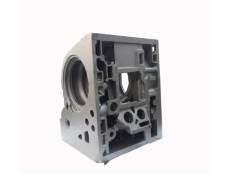+86 311 85258258
+86 311 85258258
May. 20, 2020
Forgings and castings are often used in industrial production. Although the distance between the two is only one word, due to their different manufacturing processes, the internal organization of these two types of workpieces is also very different, so the detection method is also very different. OEM metal parts manufacturer shares with you:
Forging concept:
Forgings use forging equipment to forge bars. Generally, it is not possible to forge more complex workpieces, which requires a lot of processing. machining. The advantages of forgings are the mainly extendable length and shrinkable cross-section.
Casting concept:
A steel casting is a metal object obtained by a casting method, that is, pouring molten metal into a previously prepared mold by casting, injection molding, suction, or other methods. (See casting cleaning) and post-processing (see casting post-processing), the resulting objects have a certain shape, size, and performance.
Whether it is casting or forging, in order to ensure the quality and safety of the product, the workpiece must be non-destructively inspected. Due to the different internal organization of the two artifacts, the test methods and test considerations are also different. The differences between ultrasonic testing in castings and forgings are explained below.
About forging inspection:
There are only two sources of defects in forgings: one is caused by defects in the ingot; the other is caused by defects in the ingot. The other is the defects generated during the forging process and the heat treatment process.
Currently, the main defects of forgings are shrinkage, shrinkage, slag inclusions, cracks, wrinkles, and white spots. Due to forging deformation, defects in forging usually have a certain directionality. Therefore, in order to obtain the best detection effect, it is necessary to consider the deformation of the forging process and the direction of the streamline when selecting the sound beam incident surface and the incident direction during the forging inspection process. The direction of the ultrasonic beam may be perpendicular to the direction of the forging streamline.
A major advantage of forgings is that the internal structure grains are very fine, so the attenuation and scattering of ultrasonic waves caused by them are very small. Therefore, a higher detection frequency can be used on forgings. At the same time, it can meet the requirements of high-resolution inspection and achieve smaller size defects.

Metal Casting
About metal casting parts inspection;
The defects of castings mainly include the following categories: hole defects (including shrinkage, shrinkage, looseness, pores), crack cold insulation (cold cracks, hot cracks, white spots, heat treatment cracks), slag defects, etc. Over time, due to stress, cracks often occur in castings with fast cooling speeds, complex geometric shapes, and large cross-sectional dimensions. This defect is the most dangerous.
Due to the uneven and dense structure of the casting, the surface is rough and the shape is complex, resulting in poor ultrasonic penetration and severe clutter interference.
In summary, the main common points and differences between ultrasonic testing in castings and forgings are as follows:
Common ground
1. The instrument is the same, including the probe, connecting cable, and display.
2. The same coupling agent.
3. The detection theory is the same (physical theory).
4. The same purpose (all purposes are to ensure the quality of the workpiece).
Distinction:
1. Due to the different fineness of the internal tissue particles, the ultrasonic attenuation of the casting is very serious, and high-frequency defect detection cannot be carried out (otherwise, the clutter is very large and it is easy to confuse the defect wave and chaos).
2. The requirements are different. The quality level of forgings is very high, and the requirements for castings are much lower than the requirements for forgings. Therefore, the evaluation criteria are different.
3. The causes and types of defects are different.
Another: There are no absolute advantages and disadvantages for the two materials. Many factors need to be considered in engineering applications. Only the most suitable is the best.